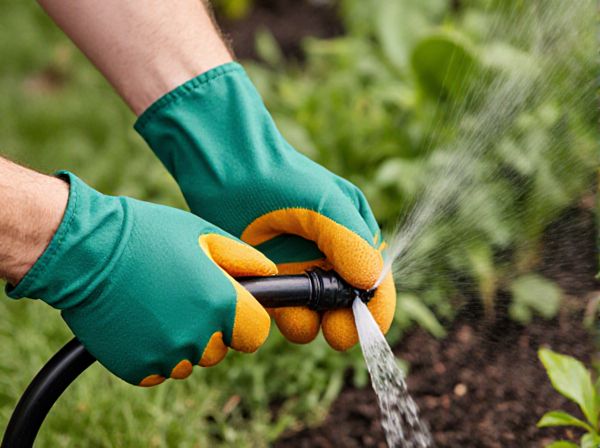
Drip irrigation vs hand watering Illustration
Drip irrigation delivers water directly to the plant roots through a network of tubes and emitters, ensuring efficient water usage and reducing evaporation. Hand watering allows precise control but is time-consuming and less consistent, often leading to uneven moisture levels. For container gardening, drip irrigation provides a more reliable and automated solution to maintain optimal soil moisture.
Table of Comparison
| Feature | Drip Irrigation | Hand Watering |
|---|---|---|
| Water Efficiency | High - delivers water directly to plant roots, minimizing waste | Low - more water lost due to evaporation and runoff |
| Labor | Low - automated or semi-automated system | High - requires manual effort and time |
| Cost | Moderate to High initial investment; low operating cost | Low initial cost; higher labor expenses over time |
| Water Control | Precise - adjustable flow rates and scheduling | Variable - depends on user attention and consistency |
| Plant Health | Improved - consistent moisture reduces stress and disease | Variable - uneven watering can cause stress and disease |
| Setup Complexity | Requires installation and maintenance | Simple - no installation needed |
Introduction to Container Gardening Watering Methods
Drip irrigation delivers water directly to the container's root zone, minimizing evaporation and ensuring consistent moisture for optimal plant growth. Hand watering allows for precise control over soil moisture but can lead to uneven distribution and potential overwatering. Choosing the right method depends on container size, plant type, and watering frequency to maintain healthy roots and efficient water use.
What Is Drip Irrigation for Containers?
Drip irrigation for containers is a precise watering system that delivers water directly to the plant's root zone through small emitters or tubes, minimizing water waste and ensuring consistent moisture levels. This method enhances plant growth by providing a steady supply of water tailored to container plants' specific needs, reducing the risk of overwatering or underwatering. Compared to hand watering, drip irrigation offers efficiency, automation potential, and improved water conservation, especially beneficial for container gardening in limited spaces.
Hand Watering: Traditional Approach Explained
Hand watering remains a traditional, effective method for container gardening, allowing precise control over water application to individual plants. This technique helps prevent overwatering and ensures that roots receive adequate hydration, especially in small or delicate containers. Regular monitoring and manual adjustment can optimize plant health by accommodating varying water needs across different species and environmental conditions.
Water Efficiency: Drip Irrigation vs Hand Watering
Drip irrigation delivers water directly to plant roots through a network of tubes and emitters, reducing evaporation and runoff to achieve up to 90% water efficiency. Hand watering often results in uneven distribution and higher water loss due to surface runoff and evaporation, lowering overall water efficiency to approximately 50-60%. Choosing drip irrigation in container gardening maximizes water conservation by precisely targeting moisture needs and minimizing waste.
Impact on Plant Health and Growth
Drip irrigation delivers a consistent and precise amount of water directly to the plant roots, minimizing water stress and promoting healthier root development and robust growth. Hand watering often results in uneven moisture distribution, increasing the risk of either under-watering or overwatering, which can lead to root diseases and stunted growth. Efficient moisture control via drip systems supports optimal nutrient uptake, enhancing overall plant vitality and productivity.
Time and Labor: Convenience Comparison
Drip irrigation systems significantly reduce time and labor by delivering water directly to plant roots through automated tubing, minimizing manual effort and ensuring consistent hydration. Hand watering demands more frequent attention and physical work, especially for multiple containers, resulting in higher labor intensity and time consumption. This convenience factor makes drip irrigation a more efficient choice for container gardening, optimizing water use and freeing up time for other gardening tasks.
Cost Analysis: Setup and Maintenance
Drip irrigation systems for containers involve higher initial setup costs due to the need for tubes, emitters, and timers, but they offer significant savings in water usage and reduced labor over time. Hand watering has negligible upfront equipment expenses but incurs ongoing labor costs and often higher water consumption, making it less efficient financially for large numbers of containers. Long-term maintenance costs for drip systems include occasional emitter replacements and system checks, whereas hand watering requires continuous manual effort without significant hardware upkeep.
Water Distribution: Consistency and Precision
Drip irrigation delivers water directly to the plant's root zone through emitters, ensuring consistent and precise moisture levels that reduce water waste and promote healthy growth. Hand watering often leads to uneven water distribution, with some areas receiving excessive moisture while others remain dry, causing stress to plants and inefficient water use. The targeted approach of drip systems enhances water efficiency and supports optimal container plant health.
Common Challenges and Troubleshooting
Drip irrigation systems frequently encounter clogging issues caused by mineral buildup or debris, requiring regular filter maintenance and emitter flushing to ensure optimal water flow. Hand watering challenges include uneven moisture distribution and potential root disturbance, often mitigated by using watering wands or soaker hoses for gentle, consistent delivery. Both methods demand monitoring soil moisture levels to prevent overwatering or underwatering, which can stress container plants and reduce growth.
Choosing the Best Method for Your Container Garden
Drip irrigation delivers precise, consistent moisture directly to the root zone of container plants, minimizing water waste and reducing the risk of diseases caused by overwatering. Hand watering allows for more control over individual plant needs but can be time-consuming and may lead to uneven moisture distribution in containers. Selecting the best method depends on factors such as the size of the container garden, plant types, and frequency of watering required for healthy growth.
Drip irrigation vs hand watering Infographic

 gardendif.com
gardendif.com